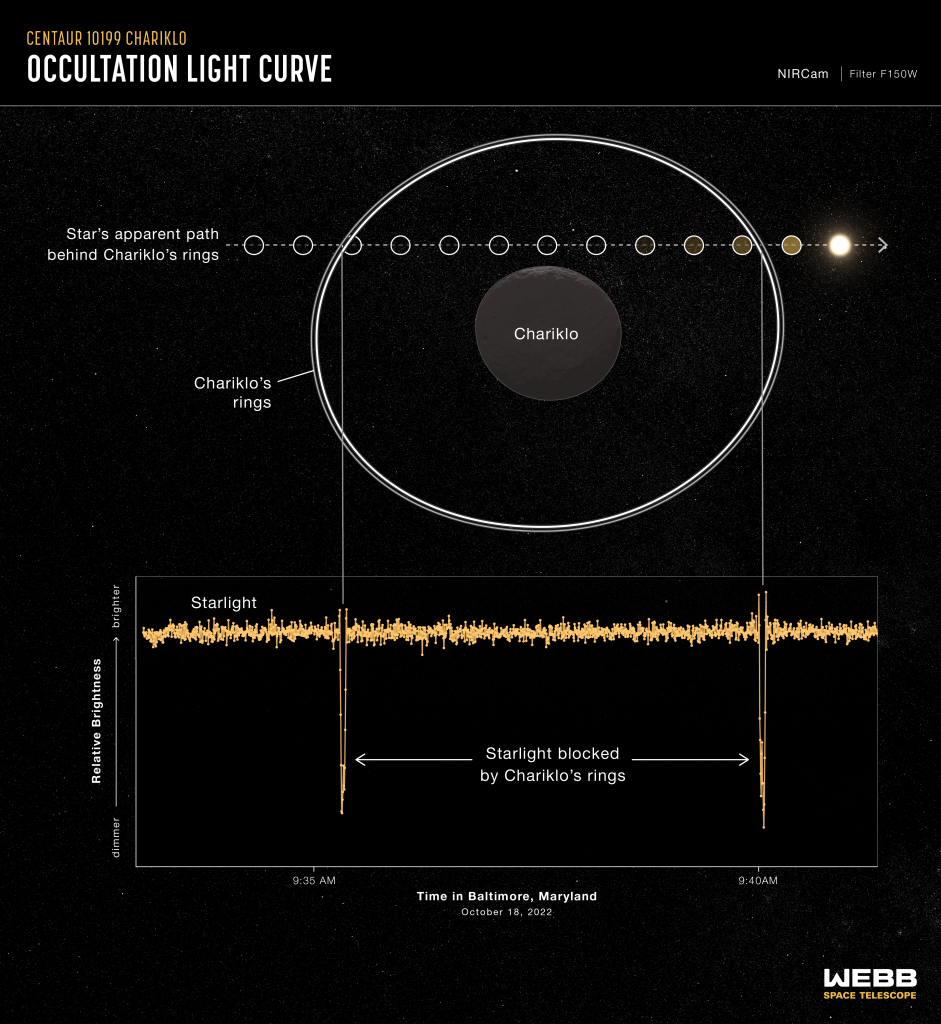It looks like you're using an Ad Blocker.
Please white-list or disable AboveTopSecret.com in your ad-blocking tool.
Thank you.
Some features of ATS will be disabled while you continue to use an ad-blocker.
9
share:
Asteroid Chariklo was discovered in 1997 but it wasn't until 2013 when astronomers observed Chariklo pass a distant Star they discovered that the
asteroid has its very own system of rings making it the first asteroid discovered with a ring system , previously only large planets were know to host
rings.
Fast forward to October 2022 and astronomers looked at Chariklo again as it passed a Star but this time they were armed with NASA's shiny new Webb Space Telescope.

Webb couldn't see the rings as Chariklo is over two billion miles away and quite small , it has a diameter of about 188 miles , but spectrographic data confirmed the 2 rings and discovered they're made up of water ice.

Space is like waiting for a bus , wait for ages then 3 turn up together.
Fast forward to October 2022 and astronomers looked at Chariklo again as it passed a Star but this time they were armed with NASA's shiny new Webb Space Telescope.
This video shows observations taken by NASA’s James Webb Space Telescope of a star (fixed in the center of the video) as Chariklo passes in front of it. The video is composed of 63 individual observations with Webb’s Near-infrared Camera Instrument’s view at 1.5 microns wavelength (F150W) obtained over ~1 hour on Oct. 18. Careful analysis of the star’s brightness reveals that the rings of the Chariklo system were clearly detected.

Webb couldn't see the rings as Chariklo is over two billion miles away and quite small , it has a diameter of about 188 miles , but spectrographic data confirmed the 2 rings and discovered they're made up of water ice.
The spectrum of the system shows three absorption bands of water ice in the Chariklo system. Noemí Pinilla-Alonso, who led Webb’s spectroscopic observations of Chariklo, explained: “Spectra from ground-based telescopes had hinted at this ice (Duffard et al. 2014), but the exquisite quality of the Webb spectrum revealed the clear signature of crystalline ice for the first time.” Dean Hines, the principal investigator of this second GTO program, added: “Because high-energy particles transform ice from crystalline into amorphous states, detection of crystalline ice indicates that the Chariklo system experiences continuous micro-collisions that either expose pristine material or trigger crystallization processes.”

An occultation light curve from Webb’s Near-infrared Camera (NIRCam) Instrument at 1.5 microns wavelength (F150W) shows the dips in brightness of the star (Gaia DR3 6873519665992128512) as Chariklo’s rings passed in front of it on Oct. 18. As seen in the illustration of the occultation event, the star did not pass behind Chariklo from Webb’s viewpoint, but it did pass behind its rings. Each dip actually corresponds to the shadows of two rings around Chariklo, which are ~4 miles (6-7 kilometers) and ~2 miles (2-4 kilometers) wide, and separated by a gap of 5.5 miles (9 kilometers). The two individual rings are not fully resolved in each dip in this light curve.
blogs.nasa.gov...
Space is like waiting for a bus , wait for ages then 3 turn up together.
Such incredibly cool discoveries, of course, it could be an alien species mining the asteroid.
Is it me or does it seem we are probing the cosmos with more urgency than ever before? or is it just that Webb is just giving them all kinds of discoveries?
Is it me or does it seem we are probing the cosmos with more urgency than ever before? or is it just that Webb is just giving them all kinds of discoveries?
a reply to: putnam6
I think it's because we have so many science instruments scanning the heavens now , both in space and on the ground, we have an abundance of data coming in.
It won't be long until we get an indication of life on another Planet ... or perhaps Moon.
I think it's because we have so many science instruments scanning the heavens now , both in space and on the ground, we have an abundance of data coming in.
It won't be long until we get an indication of life on another Planet ... or perhaps Moon.
edit on 30-1-2023 by gortex because: (no reason given)
Yes, it's crazy.
The world could be burning down, on the brink of cataclysm, world war III, billions starving, you can pick the doom scenario or a few of them.
And yet, despite not even being back to the moon with mars a distant fantasy of a billionaire, here we are trying to observe EVERYTHING from the beginning of the universe with telescopes that cost many billions of dollars, intricately placed in outer space to get the best view.
It's almost like a distraction, it doesn't really benefit humanity much. I'm not against it, don't get me wrong, it's just.. kinda weird the obsession science has with it now. We can't even get down the street in our own solar system if the SHTF, but we can see 13 billion years into the past a bunch of stuff that looks nothing like it currently does when we see it, if it even exists anymore at all.
The world could be burning down, on the brink of cataclysm, world war III, billions starving, you can pick the doom scenario or a few of them.
And yet, despite not even being back to the moon with mars a distant fantasy of a billionaire, here we are trying to observe EVERYTHING from the beginning of the universe with telescopes that cost many billions of dollars, intricately placed in outer space to get the best view.
It's almost like a distraction, it doesn't really benefit humanity much. I'm not against it, don't get me wrong, it's just.. kinda weird the obsession science has with it now. We can't even get down the street in our own solar system if the SHTF, but we can see 13 billion years into the past a bunch of stuff that looks nothing like it currently does when we see it, if it even exists anymore at all.
edit on CST12Mon, 30 Jan 2023 12:47:26
-060000000001b2023 by Thrumbo because: (no reason given)
new topics
-
Trump is NOT Racist
US Political Madness: 21 minutes ago -
"I'm seeing Red" by Jesslee and the Marine
Music: 1 hours ago -
Black Holes Could Be The Mysterious Force Expanding The Universe
Science & Technology: 1 hours ago -
Kamala is running pro Palestine ads While simultaneously running pro Israel ads
2024 Elections: 5 hours ago -
Trump holds final campaign rally in Michigan before voting begins Tuesday
2024 Elections: 5 hours ago -
Almost Home
Short Stories: 8 hours ago -
Kamala finally builds a wall...around her home in DC
Jokes, Puns, & Pranks: 9 hours ago -
Ok Melbourne, Really?
Music: 11 hours ago
top topics
-
Predictions for the result
2024 Elections: 14 hours ago, 12 flags -
Trump holds final campaign rally in Michigan before voting begins Tuesday
2024 Elections: 5 hours ago, 11 flags -
Kamala is running pro Palestine ads While simultaneously running pro Israel ads
2024 Elections: 5 hours ago, 11 flags -
Kamala finally builds a wall...around her home in DC
Jokes, Puns, & Pranks: 9 hours ago, 8 flags -
Almost Home
Short Stories: 8 hours ago, 6 flags -
Black Holes Could Be The Mysterious Force Expanding The Universe
Science & Technology: 1 hours ago, 5 flags -
"I'm seeing Red" by Jesslee and the Marine
Music: 1 hours ago, 4 flags -
Ok Melbourne, Really?
Music: 11 hours ago, 1 flags -
Trump is NOT Racist
US Political Madness: 21 minutes ago, 1 flags
9
